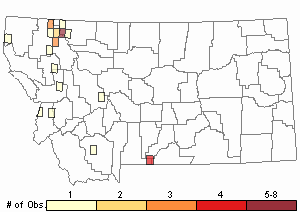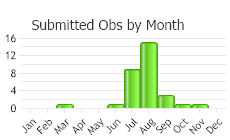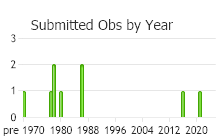View in other NatureServe Network Field Guides
NatureServe
Montana
Utah
Wyoming
Idaho
Wisconsin
British Columbia
South Carolina
Yukon
California
New York
Agassiz's Schistidium Moss - Schistidium agassizii
Other Names:
A Black Rock Moss
General Description
Plant: Loose mats; rarely in compact tufts or mats. Dark olivaceous and sometimes brown to black. Stems 0.9-5 cm tall. Central strand of stem in X-S is absent or not distinct.
Leaf: When dry, leaf is somewhat contorted. Leaf erect or curved (often towards stem), linear-lanceolate to ligulate, sometimes oblong-lanceolate, and 1-3.5 mm long. Proximal portion of leaf is weakly keeled or concave with margins that are plane or weakly recurved. Distal portion of leaf is usually flat, sometimes concave, and occasionally weakly keeled with margins that are plane (rarely incurved), smooth or weakly crenulate or sometimes eroded. Apex is obtuse to acute, occasionally ending in a hyaline cell, but with no awn. Costa is subpercurrent to percurrent and smooth.
Leaf Cells: XS: Distal portion of leaf is 1-layer and sometimes with portions of 2-layers. Basal laminal cells near margin are short-rectangular or quadrate. Median to upper laminal cells are quadrate or short-rectangular, usually rounded, smooth or weakly sinuose, and 7-12 µm wide.
Phenology
Capsules mature from late spring to early summer.
Diagnostic Characteristics
Species can be confused with S. rivulare (occurs throughout Canada and USA, except not the southeast and Texas) and S. subjulaceum (not known in ID/MT/ND) because they share the same habitats.
Range Comments
Greenland; Canada: AB, BC, NB, NS, ON, YT; USA: AK, CA, CO, ID, ME, MD, MA, MI, MN, MT, NY, OR, UT, WA, WY; Eurasia (FNA 2007). Known in Montana from Flathead, Glacier, Lake, Lewis and Clark, Lincoln, Missoula, Park, and Ravalli Counties (Elliott 2016).
Observations in Montana Natural Heritage Program Database
Number of Observations: 31
(Click on the following maps and charts to see full sized version)
Map Help and Descriptions
Relative Density

Recency


 (Observations spanning multiple months or years are excluded from time charts)
(Observations spanning multiple months or years are excluded from time charts)
Habitat
Wet or dry rocks in or along streams and lakes. Low to high elevations (650 – 11,000 feet).
Reproductive Characteristics
Autoicous. Capsules are light brown to almost black, campanulate (rarely cupulate), 0.8-1.5 mm long.
Stewardship Responsibility
References
- Literature Cited AboveLegend:
 View Online Publication
View Online Publication Elliott, J.C. and A.K. Pipp. 2018. A Checklist of Montana Mosses (1880-2018). Updated 3 January, 2020. Montana Natural Heritage Program, Helena, Montana. 73 pp.
Elliott, J.C. and A.K. Pipp. 2018. A Checklist of Montana Mosses (1880-2018). Updated 3 January, 2020. Montana Natural Heritage Program, Helena, Montana. 73 pp. Flora of North America Editorial Committee, eds. 2007. Flora of North America North of Mexico. Volume 27. Bryophytes: Mosses, Part 1. Oxford University Press, Inc., NY. xxi + 713 pp.
Flora of North America Editorial Committee, eds. 2007. Flora of North America North of Mexico. Volume 27. Bryophytes: Mosses, Part 1. Oxford University Press, Inc., NY. xxi + 713 pp.
- Additional ReferencesLegend:
 View Online Publication
View Online Publication
Do you know of a citation we're missing? Elliot, J. C. 1993. Second checklist of Montana mosses. Unpublished report. U.S. Forest Service, Region 1. Missoula, MT. 45 pp.
Elliot, J. C. 1993. Second checklist of Montana mosses. Unpublished report. U.S. Forest Service, Region 1. Missoula, MT. 45 pp. Lawton, E. 1971. Keys for the Identification of the Mosses on the Pacific Northwest. Reprinted from 'Moss Flora of the Pacific Northwest'. Published as Supplement No. 2 of the Journal of the Hattori Botanical Laboratory. Nichinan, Miyazaki, Japan. 66 pp.
Lawton, E. 1971. Keys for the Identification of the Mosses on the Pacific Northwest. Reprinted from 'Moss Flora of the Pacific Northwest'. Published as Supplement No. 2 of the Journal of the Hattori Botanical Laboratory. Nichinan, Miyazaki, Japan. 66 pp. Lawton, E. 1971. Moss Flora of the Pacific Northwest. Hattori Botanical Laboratory. Japan: Yamabuki-cho, Shinjuku-ku, Tokyo. 362 pages plus appendices.
Lawton, E. 1971. Moss Flora of the Pacific Northwest. Hattori Botanical Laboratory. Japan: Yamabuki-cho, Shinjuku-ku, Tokyo. 362 pages plus appendices.
- Web Search Engines for Articles on "Agassiz's Schistidium Moss"





